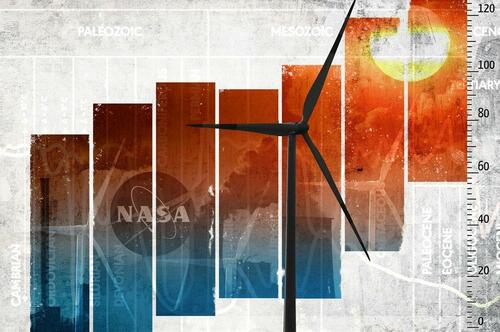‘Pure Junk Science’: Researchers Challenge Narrative On CO2 And Warming Correlation
Authored by Katie Spence via The Epoch Times (emphasis ours),
Each year from 2023 to 2030, climate change sustainable development goals will cost every person in economies such as the United States $2,026, the U.N. Conference on Trade and Development estimates. In lower-income economies, the per-person annual cost ranges from $332 to $1,864.
In total, the global price tag comes to about $5.5 trillion per year.
Separately, a report from the left-aligned nonprofit Climate Policy Initiative found that in 2021 and 2022, the world’s taxpayers spent $1.3 trillion each year on climate-related projects.
It also found that the “annual climate finance needed” from 2031 to 2050 is more than $10 trillion each year.
“Anyone who willfully denies the impact of climate change is condemning the American people to a very dangerous future,” President Joe Biden said on Nov. 14, 2023, while announcing $6 billion in new investments through the Inflation Reduction Act (IRA).
“The impacts we’re seeing are only going to get worse, more frequent, more ferocious, and more costly.”
At its signing in August 2022, President Biden said the IRA “invests $369 billion to take the most aggressive action ever—ever, ever, ever—in confronting the climate crisis and strengthening our economic—our energy security.”
A report from Goldman Sachs put the dollar amount much higher, stating, “Critical funding for this next energy revolution is expected to come from the IRA, which will provide an estimated $1.2 trillion of incentives by 2032.”
The trillions of dollars being poured into new initiatives stem from the goals set by the United Nations’ Paris Agreement’s legally binding international treaty to “substantially reduce global greenhouse gas emissions” in the hope of maintaining a temperature of no more than 1.5 degrees Celsius above pre-industrial levels.
But any decrease in carbon dioxide (CO2) emissions won’t have an effect for hundreds to thousands of years—even under the most restrictive circumstances, according to some experts.
“If emissions of CO2 stopped altogether, it would take many thousands of years for atmospheric CO2 to return to ‘pre-industrial’ levels,” the Royal Society states in a report on its website. The organization describes itself as a “fellowship of many of the world’s most eminent scientists.”
“Surface temperatures would stay elevated for at least a thousand years, implying a long-term commitment to a warmer planet due to past and current emissions,” the report states. “The current CO2-induced warming of Earth is therefore essentially irreversible on human timescales.”
A frequently asked questions page on NASA’s website holds the same position.
“If we stopped emitting greenhouse gases today, the rise in global temperatures would begin to flatten within a few years. Temperatures would then plateau but remain well-elevated for many, many centuries,” NASA states.
And, other scientists say, that’s because CO2 isn’t the culprit in the first place.
“CO2 does not cause global warming. Global warming causes more CO2,” said Edwin Berry, a theoretical physicist and certified consulting meteorologist. He called Royal Society’s position on CO2 “pure junk science.”
Ian Clark, emeritus professor for the Department of Earth and Environmental Sciences at the University of Ottawa, agreed that if all greenhouse gas emissions ceased today, the Earth would continue warming—but not because of CO2.
He said that contrary to popular opinion, temperature doesn’t follow CO2—instead, CO2 follows temperature, which, itself, is due to solar activity.
Temperature and CO2
One of Mr. Clark’s primary areas of research is paleoclimatology (the study of climate conditions using indirect records such as tree ring data, ice cores, and other proxy records), and in particular, Arctic paleohydrogeology, which is the study of the Earth’s water throughout history.
“During the ice ages, we had great temperature variations, and this has to do with, not straight-up solar activity, but the amount of solar activity that is hitting the Earth at certain important latitudes, all caused by celestial events,” Mr. Clark said.
“The Earth, in our solar system, is moving around and being jostled. And we have different orbiting patterns that affect solar input, and that creates ice ages and interglacial periods—which we’re in now. And CO2 tracks that. So we’ll see enormous temperature changes, going from ice ages to interglacials, and CO2 gets very low during ice ages and very high during interglacials.
“And that gives the appearance that CO2 is driving the climate, but it’s actually following. It lags by about 800 years.”
Mr. Clark said that during ice ages, and particularly the past 10,000 years, scientists have a fairly good idea of the temperature, thanks to proxy records. He said those records show that the Medieval Warm Period was likely much warmer than today, and agriculture and civilization flourished.
But the Little Ice Age followed that from the 1400s to 1800s. “And that’s when we had difficulty with agriculture,” Mr. Clark said.
“The Thames froze over. We have all sorts of recollections about how cold, and some would say miserable, it was back then. But then it started warming up again. So, about every 1,000 years or so, we seem to have these fluctuations. This is due to solar activity, and that’s where we see the importance of the sun, which is the ultimate source of energy beyond geothermal and nuclear energy. Solar drives climate.”
Another peer-reviewed study, by scientist William Jackson, examined the relationship between CO2 levels and temperature over the past 425 million years.
Mr. Jackson is a distinguished research and emeritus professor for the department of chemistry at UC–Davis who specializes in understanding the role that molecules such as CO2, nitrogen, and carbon monoxide play in planetary atmospheres.
His paper, published in 2017, found that “changes in atmospheric CO2 concentration did not cause temperature change in the ancient climate.”
Similarly, a group of researchers whose report was published in Nature found that when looking at carbon isotope compositions at the million-year scale, long-term atmospheric carbon dioxide was unrelated to temperature, and even showed an inverse trend, especially after major events such as volcanic eruptions.
They further found that when temperature and atmospheric CO2 reached a certain level, organic carbon burial drastically increased, eventually resulting in a significant decrease in atmospheric CO2 levels.
That activity, Mr. Berry said, is nature balancing the levels of CO2—which is an ongoing process.
Read more here…
Tyler Durden
Wed, 02/21/2024 – 02:00
via ZeroHedge News https://ift.tt/CjZFGBb Tyler Durden



